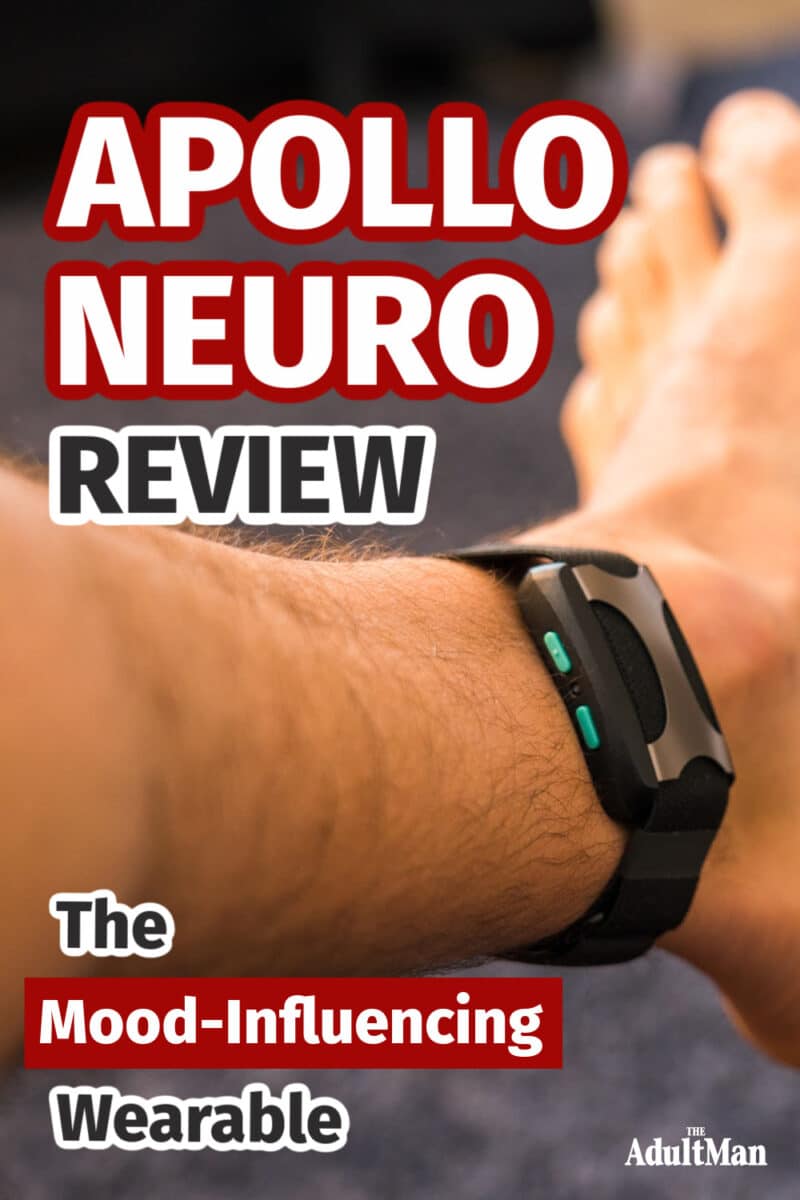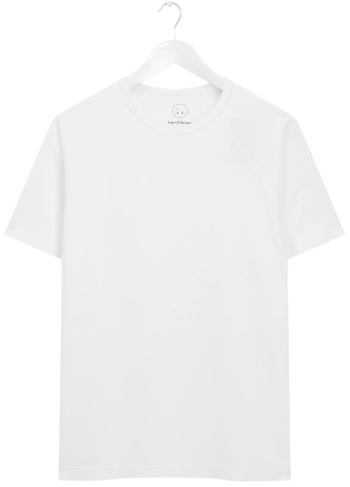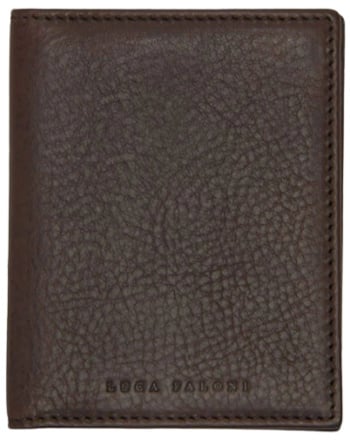Have you ever felt like you suddenly turned into a thick, anxious, inescapable, chest-tightening ball of stress?
It’s not uncommon. With technology firmly rooted in our daily lives, we’re constantly bombarded with a rapidfire flurry of dings, buzzes, emails, updates, calls, and notifications.
Apollo Neuro built a wearable that gives you extra ammo in the fight against stress. I strapped it on and gave it a thorough
Is it godlike, or just a gimmick? Read on to see why it’s neither.
Skip Ahead
Apollo Neuro Overview

Apollo is an innovative, science-backed wearable created by Apollo Neuroscience built to train the body’s response to stress. It does this by emitting soft vibrations that influence one’s heart rate variability (HRV) and activates the parasympathetic nervous system. Apollo claims this restores balance to the body and leads to better sleep, focus, and energy production.
Apollo was co-founded in 2016 by Dr. David Rabin, MD, PhD and his wife, Kathryn Fantauzzi. Dr. Rabin is a board-certified psychiatrist and neuroscientist who specializes in the treatment of chronic stress. Kathryn, CEO of the brand, specializes in bringing discoveries out of the lab and into the real world.
Perhaps the biggest thing to note is that, unlike other sophisticated wearables in the market such as Whoop, Apple Watch, or FitBit, Apollo aims to improve one’s biometrics—not merely track them.
Things to Consider Before Buying a Wellness Wearable

Wellness devices and wearables have sprouted up to combat the stress-inducing lifestyle often associated with a technology dependent world.
Today, the average person is hammered with an onslaught of notifications that shock them into an alert and unsettled state of mind. Wellness wearables aim to minimize stress and improve user’s overall health.
Anyone who is looking for help lowering their day-to-day stress could benefit from Apollo’s wearable and others on the market.
A niche wellness wearable like Apollo, however, is not to be confused with other fitness and health-related wearables which are primarily designed to track daily activity, biometrics, and other functions.
Adapt to every rhythm of life with this wearable designed to help you de-stress, focus, and fight through that mid-afternoon sleepy period that gets me every. single. time.
Apollo Neuro Review
Packaging

Apollo comes in a compact package containing an ankle strap, wrist strap, charging cord, and manual. You also get access to the Apollo Neuro App (iOS and Android) which I found was the most seamless way to get started.
Device and Straps
The device itself is similar in size to a FitBit or Apple Watch. Though, Apollo is much more understated in design, with just two light blue buttons on the side, and a small metal piece for the strap to slip through. No screen, dials, or knobs.

Apollo looks slightly like a tracker. But that’s okay—the device isn’t meant to be seen or noticed. It’s purely for functionality. You won’t be checking it the way you would another wearable which might display notifications or data on a small screen for you. With Apollo, you sort of set it and forget it, and let it buzz it’s magical vibrations through your body.
While you can wear it on top of the wrist like a watch, the Apollo team suggests wearing it inside the ankle or wrist, as the most optimal areas for feeling these gentle vibrational pulses.

Apollo comes with a medium and large strap which fits most adult wrists and ankles. The strap is made of neoprene (the same material used to make wetsuits) with polyester overlays. The strap lays thinly against your skin, similar to a fabric watch band. While it’s soft to the touch, it still feels quite durable and strongly woven.
The strap connects to itself with thin, firm velcro, keeping the band snug and secure. This is nice if you are on a walk or moving around your house and don’t want Apollo to slide around.
First Use
Nearing the end of a chaotic Friday jam packed with emails, projects, and phone calls, I grabbed a glass of wine, fired up the Apollo app, and clicked on one of the seven modes to get started.

I opted for a full 60-minute “Relax and Unwind” session, which says it “rapidly relieves stress for deep relaxation.”
In favor of convenience, I slipped Apollo on inside my wrist and strapped it down snugly.
I was a tad nervous for what these “gentle waves of vibration” were going to feel like. But I was pleasantly surprised.
Apollo emits faint vibrations in a soft succession that you eventually forget are even there. In about ten minutes, I felt the tightly strung, work-related stress start to wither away and become an afterthought.
Though, I wasn’t certain if it was due to Apollo itself or the glass of Pinot in my hand and the fact that I had logged off email all together by that point. I was intrigued, but keen on trying Apollo by itself the next time.
Modes and Intensity
Apollo comes equipped with a comprehensive menu of different modes that cover just about every desired mood you might wish to be in throughout a full day.
There are seven modes altogether which include:
- Energy and Wake Up
- Social and Open
- Clear and Focused
- Rebuild and Recover
- Meditation and Mindfulness
- Relax and Unwind
- Sleep and Renew
Using the two buttons on the device,or the slider on the app,you can toggle the intensity up or down on a scale of 1-100 percent.
During my first few tries, I notched it up to somewhere between 90 and 100% and left it there comfortably for the remainder of the session. After this, I almost always opted for 100%, but you might find you enjoy a milder intensity.

From sunrise to sundown, I found that I typically used each mode as they were listed chronologically.
There were exceptions, like those sluggish evenings when I wanted to take a nap at 3pm. Instead, I cranked on the “Energy and Wake Up” mode for 30 minutes to see if I could muster some alertness. I will say it left me feeling ready to tackle more work and thinking more clearly.
The Science & Technology
One of Apollo’s most effective marketing points is that their technology was born in a lab and is tested and backed by science and research.
The research, conducted by Dr. Rabin and his partner at University of Pittsburgh, revolved around the application of low frequency sound waves and how they can influence how you feel through sense of touch.
I found the opening paragraph on the science tab of Apollo’s website to be frighteningly relatable: “Have you ever felt like you had so much to do that you can’t focus on anything? Have you laid awake at night unable to sleep because your mind is racing? Have you had such a stressful day that your body feels run down and sore?”
I won’t crack open a dusty textbook on you, but dipping a toe into the science does help understand why this wearable was created in the first place.

The sympathetic nervous system is in charge of your “fight-or-flight” response. It kicks in when you are threatened and need to act to survive. It elevates your heart rate and blood pressure. Only in the modern day, a sassy six paragraph email from your boss can kick this into action, no grisly meat-eating predator required.
On the flip side, your parasympathetic nervous system is in charge of conserving energy, lowering your heart rate and blood pressure, and calming you down. In this state, you feel safe and primed to be creative, relaxed, and even meditative.
Those little vibrations Apollo emits—that come and go like ocean waves—are meant to signal to your brain “hey man, there’s no grisly meat-eating predator present, so you can chill out and breath deep, bro.”
Apollo uses your sense of touch to change the balance of your nervous system. Even more impressive, the vibrational frequencies match the natural oscillation pattern between your heart and your lungs.
You can learn more on Apollo’s website which lists 54 ongoing research studies.
Adapt to every rhythm of life with this wearable designed to help you de-stress, focus, and fight through that mid-afternoon sleepy period that gets me every. single. time.
Effectiveness and Mood Changes
So what you really want to know is: does it work? I don’t blame you. There’s a boatload of gimmicks out there.
After all, when supplements, apps, or wearables claim to make us feel happier, healthier, stronger, or more productive—I think we all furrow our brows with discernment and think, “oh, yeah? Prove it!”
So, does this wearable designed by a credentialed neuroscientist really work? Or is it a pile of placebo vibrating bull?
The short answer is, yes, it works. The long answer is, it depends on your goals, lifestyle, and willingness to feel how you truly intend to.
If you turn on a “Sleep and Renew” session but you’re sitting in front of a blaring screen munching down late night snacks, you probably won’t cleanly drift off into a heavy slumber that leaves you feeling renewed.
But if you turned on the same session while situated in bed in a dimly lit room and read a couple pages of fiction, this mode would work to heighten that fully relaxed, ready for sleep state.
I’m not going to make any tabloid claims about Apollo zapping me into an emotional nirvana where I can alter my moods at will. If you’ve seen “Limitless” with Bradley Cooper, I think you get the picture. If it worked that way, you probably wouldn’t be able to get your hands on one of these casually online.
Apollo works to prime the mind for your desired state. Here’s an example, one Sunday while punching out an article, I dipped into a lethargic, fuzzy mood. I can’t write in this mood. At least, not with great clarity.
I strapped Apollo around my ankle and flicked on an “Energy and Wake Up” session in the app. Then, I sat back patiently for a few minutes and directed my attention toward what I was feeling.
Soon enough, I felt the brain fog lift off a bit. I felt like there was a clearer path between my brain, my keyboard, and words on the screen.
But-, I paired this Apollo session with a glass of water and a short break on my patio to breathe some fresh air and stretch my limbs for a couple minutes, which likely helped.

Adding Apollo to your daily routine is like turning your car into a hybrid. It’s not going to drive itself, and you still need to stop at gas stations along the way, but that electric boost is going to give you some extra mileage and propel you further along your desired path.
I don’t believe Apollo’s controlled vibrations are placebo. But even if they were, just by clicking on a desired mood and feeling the device against my skin, it helps me be aware of my intended mood and move closer to that feeling.
What do Other Reviewers Say?
Florenz V. saw the benefits of Apollo, and I agree that the focus and relax features felt the most tangible.

Here’s a blurb from a writer for a men’s magazine who tried Apollo for a week:
“The Apollo was not world-changing for me but I enjoyed having the extra measure of emotional self-manipulation. I punched into an app what mood I wanted to be in and this little companion on my ankle collaborated.”
That’s about par for my experience. It’s an extra measure that aids you in achieving your intended mood. Or, as I riffed on earlier, like upgrading your car to a hybrid for an extra boost.
My Thoughts Overall on Apollo
What I Like
Every other wearable I could find in the market spits out data and biometrics, only signaling the problem. Apollo acts as a solution, actively influencing your heart rate variability and response to stress while you wear it.
The seven modes are useful for hand-picking what type of mood you want to be in.
Comes in two simple colors: Silver and Stealth
The device and app are well-built, designed, and seamless to use.
What I Don’t Like
The price is a bit steep.
The device lacks a screen or other sleek, high-tech features boasted by other wearables.
Who is Apollo For?
Anyone who wants to actively influence their mood and their body’s response to stress. This is for people who already take proper steps to be in the right mood and want to super-charge their efforts. Apollo won’t zap you from sad to happy or tired to energized. But it will prime you for your intended mood and nudge you in the right direction.
The Verdict
Dings, buzzes, emails, texts—all act to heighten the body’s “fight-or-flight” response and leave us feeling harried, anxious, stressed, and alert all the time.
Apollo employs science-backed vibrational frequencies that influence the nervous system and signal to our brains that it’s safe to calm down and lower our heart rate and blood pressure. Unlike every other wearable in the market, Apollo actively influences your biometrics, instead of merely tracking them.
Apollo isn’t witchcraft and wizardry and it shouldn’t be treated as such. It gently nudges you on the right path toward your desired mood: it won’t steer the wheel for you. For me, it worked best when I paired it with actions to put myself in my desired mood.
Is it pricey? Yep. Is it worth it to shed a load of stress and regain control of your body’s complex functions? I’ll let you answer that.
Adapt to every rhythm of life with this wearable designed to help you de-stress, focus, and fight through that mid-afternoon sleepy period that gets me every. single. time.
FAQs
Does Apollo Neuro Work?
Apollo Neuro doesn’t instantly change your mood, but if you pair it with a short relaxing break, the effect is noticeable.
How Do You Use Apollo?
Apollo Neuro recommends wearing the device on the inside of the wrist or ankle for maximum results, but it can also be worn on the outside of either.
What Does Apollo Feel Like?
Apollo feels like “gentle waves of vibration” as the website suggests. The waves come and go at different frequencies, depending on the mode you have it in. In certain modes, the feeling is so subtle that you might forget you have it on all together.











